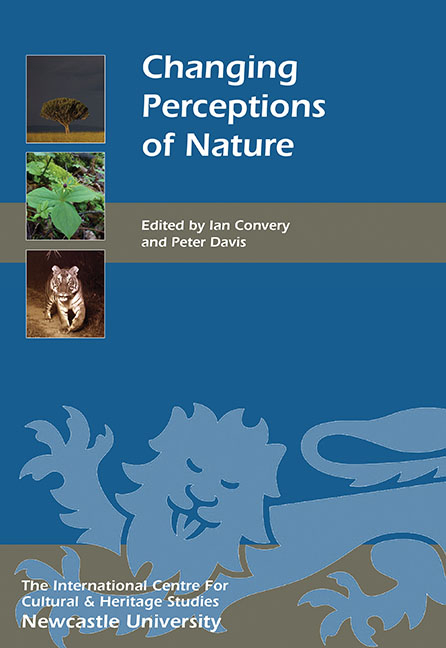Book contents
- Frontmatter
- Contents
- List of Illustrations
- Acknowledgments
- List of Abbreviations
- Foreword
- Introduction
- HISTORICAL PERSPECTIVES ON NATURE
- 1 ‘The Nomination of the Visible’: William Turner's Practice of Natural History
- 2 Early European Perceptions of the Nature of Australia
- 3 Conserving Natural Heritage: Shifting Positions of Culture and Nature
- 4 Three Birds of a Feather – Darwin, Wallace and Attenborough: An Unbroken Tradition of Finding Where the Wild Things Are
- 5 Organising, Naming and Ordering Nature
- 6 Our ‘Great Entail’: Constructing the Cultural Value of the Lake District
- COLLECTING NATURE
- INTERPRETING NATURE AND LANDSCAPES
- CONSERVING NATURE
- PEOPLE–NATURE INTERACTIONS
- List of Contributors
- Index
- Miscellaneous Endmatter
2 - Early European Perceptions of the Nature of Australia
from HISTORICAL PERSPECTIVES ON NATURE
Published online by Cambridge University Press: 26 October 2017
- Frontmatter
- Contents
- List of Illustrations
- Acknowledgments
- List of Abbreviations
- Foreword
- Introduction
- HISTORICAL PERSPECTIVES ON NATURE
- 1 ‘The Nomination of the Visible’: William Turner's Practice of Natural History
- 2 Early European Perceptions of the Nature of Australia
- 3 Conserving Natural Heritage: Shifting Positions of Culture and Nature
- 4 Three Birds of a Feather – Darwin, Wallace and Attenborough: An Unbroken Tradition of Finding Where the Wild Things Are
- 5 Organising, Naming and Ordering Nature
- 6 Our ‘Great Entail’: Constructing the Cultural Value of the Lake District
- COLLECTING NATURE
- INTERPRETING NATURE AND LANDSCAPES
- CONSERVING NATURE
- PEOPLE–NATURE INTERACTIONS
- List of Contributors
- Index
- Miscellaneous Endmatter
Summary
Australia is a paradoxical continent; an isolated, arid island, a fragment of ancient Gondwanaland. To the earliest European mariners who crossed the Indian Ocean and chanced upon the western coasts of the Great Southland or New Holland, the land in its pristine state appeared barren because it was clothed with drab, apparently useless scrub and forest that yielded no easily recognisable fruits or vegetables. They encountered no ‘civilised’ people and saw neither towns, field crops, orchards, vineyards, cattle nor sheep. The swans were black and many of the four-legged animals did not walk on allfours but hopped. Added to these anomalies, the European visitors usually had the greatest difficulty finding fresh water. Yet, Australia's unique flora (which this essay will emphasise) is richly diverse and of great scientific interest. Joseph Banks recognised the paradox when, shortly after departing in 1770, he wrote: ‘Of Plants in general the countrey afforded a far larger variety than its barren appearance seemed to promise’ (Banks 1770, f 262).
In the seventeenth and eighteenth centuries the passage across the Indian Ocean from the Cape of Good Hope to the Spice Islands was beset with hazards of many kinds. It was a very long voyage; ships from Europe often took a whole year to reach Java, especially if they went by the usual route from the Cape along the African coast in a north-easterly direction and through the tropics. However, in 1611 Hendrick Brouwer discovered that by sailing south to about 40°S and then heading east at that latitude for about a thousand Dutch miles (around 7000km) before turning north, the voyage could be shortened by about four months. As well as being quicker, this southern route, in latitudes later nicknamed the Roaring Forties, was cooler and healthier than the tropical one.
Brouwer's discovery was discussed by the directors of the Dutch East India Company (VOC) who favoured it and issued a Seynbrief (also termed a Selyaesorder) on 15 August 1617, instructing its captains to attempt this passage. Yet, it also presented many difficulties, mainly because it was not easy at that time for mariners in sailing ships to calculate distances travelled, and any vessel that maintained this course for more than a thousand Dutch miles would arrive in uncharted waters.
- Type
- Chapter
- Information
- Changing Perceptions of Nature , pp. 17 - 26Publisher: Boydell & BrewerPrint publication year: 2016

